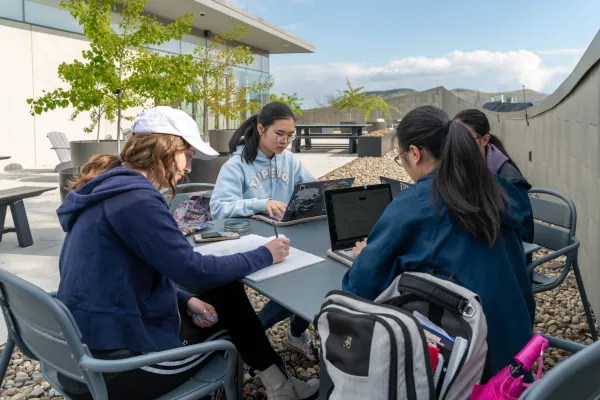For Bonus Exam Points: Who Are You?
Campus Life
When it comes to exams, some professors are leading with surprisingly supportive and helpful questions.
Published May 11, 2023
A final exam for Professor Kate Queeney’s chemistry class began this way: “What is your favorite equation or graph in CHM 332 so far? Why?”
This was followed by a meme featuring a circle of melting marshmallow chicks. “Peeps undergoing a phase transition,” it said.
As finals week draws to a close for the spring semester, some students are taking exams with a surprisingly conversational start.
Professors refer to this tactic by many names, from the pre-test, bonus or warm-up questions to positive affirmation or values affirmation questions.
Professor of Chemistry Kevin Shea has begun his exams with questions like, “Describe a time where you succeeded in something after initially struggling. How did your ultimate success make you feel?”
Professor of Physics Gary Felder begins all his exams with a five-point option. He’s asked students to name someone they admire (the most common answer is “my mother”) or talk about summer plans. A recent midterm began this way: “Studies have shown that people do better on a test if they spend a minute or two at the beginning thinking about what matters to them in life. To that end, please tell me one thing in life that you love doing.”
Adline Dely ’26 has noticed a similar approach in many different classes and ranging from exam questions to homework and classwork. In biology, a professor put pictures of kittens in slide decks and talked about adopting a cat. On chemistry homework, Dely would respond to a question about the person who inspired her and get an encouraging note from the professor in return.
The use of such tactics is by no means universal. An unofficial (and unscientific) Smith Instagram poll was almost evenly split between those who had heard of such a bonus or positive affirmation exam question (49 percent) and those who had not (51 percent).
A recent Queeney exam meme.
Among its devotees, though, the positive affirmation question is a tool with both very specific origins and particular uses. Felder began incorporating affirmation questions in 2018 after reading renowned social psychologist Claude Steele’s book Whistling Vivaldi, which included research on how reminding students of negative stereotypes (such as the notion that women don’t do well in math) can cause dips in performance.
“Conversely, questions that prompt people to think about their individual values and goals have the opposite effect, significantly reducing performance gaps,” says Felder. “So I decided to try it.”
Shea notes that the chemistry department, which he heads, has been using such exam questions for the past five years. He traces the origin back to the teaching arts luncheons at the Sherred Center for Teaching and Learning where values affirmation questions were introduced as a way to help combat exam anxiety while also being more inclusive.
Although she never used them herself, Caroline Melly, director of the Sherrerd Center and associate professor of anthropology, said the use of these questions might tie in to an ongoing shift in higher education toward “pedagogy that’s really human.” “I think you can situate this one small tactic in a range of wider tactics that try to recognize the humanity of the students while also humanizing ourselves as professors,” she says.
In humanities classes, sharing more personalized stories is often par for the course. Melly noted that lab settings are trickier for such conversations—how do you humanize an ion?—which is why exams may be more natural places for them to appear.
While a trend toward humanizing the classroom started before the pandemic, being able to see into people’s homes and lives via Zoom only accelerated it, Melly says. Rather than undercutting the seriousness of the academic work, Melly notes that sharing life stories can help create an environment where students feel safe and respected, even as they’re being challenged.
“There’s a lot of hard work going on in there,” she says. “But it allows the community formation and the trust building that real deep learning is built upon.”
In her own classes, Melly has been much more open about the “messiness of life.” When a pregnant raccoon broke into—and ultimately destroyed—her rental car, she shared the story with her class.
“I talk about moments of failure in the classroom or out of the classroom,” she says. “I am very clear with them about certain life things that have not gone as planned and what it’s taken to be resilient and to reconfigure things.”
For Queeney, and other professors, starting off an exam with a positive affirmation question can be a mutually beneficial approach.
“Whether or not this has a measurable effect on students’ performance, when I grade these, I love reading what my students are good at,” says Queeney. “It’s impossible to resist writing a smiley face or an exclamation point.”
First year Dely is more ambivalent about what’s behind such efforts. “Maybe one of the reasons is getting to know you more. But I think it’s more for the students than for the professors,” she notes.
That said, while she’s not sure if any of this actually alleviates her homework or exam stress, she has started to count on the exam questions, particularly during finals.
“I think because I’m so used to it, having an exam that doesn’t have a positive question, I’m like, ‘where is my positive question? Where is my meme?’” Dely says with a laugh.
Neilson Library study session by Sherry Li ’25

